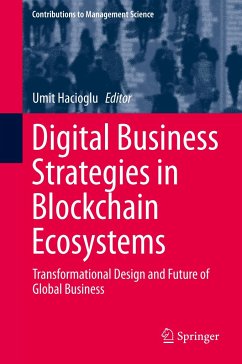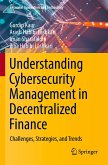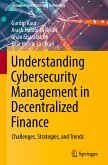Digital Business Strategies in Blockchain Ecosystems
Transformational Design and Future of Global Business
Herausgegeben:Hacioglu, Umit
Digital Business Strategies in Blockchain Ecosystems
Transformational Design and Future of Global Business
Herausgegeben:Hacioglu, Umit
- Gebundenes Buch
- Merkliste
- Auf die Merkliste
- Bewerten Bewerten
- Teilen
- Produkt teilen
- Produkterinnerung
- Produkterinnerung
This book analyzes the effects of the latest technological advances in blockchain and artificial intelligence (AI) on business operations and strategies. Adopting an interdisciplinary approach, the contributions examine new developments that change the rules of traditional management. The chapters focus mainly on blockchain technologies and digital business in the "Industry 4.0" context, covering such topics as accounting, digitalization and use of AI in business operations and cybercrime. Intended for academics, blockchain experts, students and practitioners, the book helps business strategists design a path for future opportunities.…mehr
Andere Kunden interessierten sich auch für
![Digital Business Strategies in Blockchain Ecosystems Digital Business Strategies in Blockchain Ecosystems]() Digital Business Strategies in Blockchain Ecosystems137,99 €
Digital Business Strategies in Blockchain Ecosystems137,99 €![Open and Digital Ecosystems Open and Digital Ecosystems]() Daniel FasnachtOpen and Digital Ecosystems61,99 €
Daniel FasnachtOpen and Digital Ecosystems61,99 €![Cryptofinance and Mechanisms of Exchange Cryptofinance and Mechanisms of Exchange]() Cryptofinance and Mechanisms of Exchange113,99 €
Cryptofinance and Mechanisms of Exchange113,99 €![Cryptofinance and Mechanisms of Exchange Cryptofinance and Mechanisms of Exchange]() Cryptofinance and Mechanisms of Exchange113,99 €
Cryptofinance and Mechanisms of Exchange113,99 €![Understanding Cybersecurity Management in Decentralized Finance Understanding Cybersecurity Management in Decentralized Finance]() Gurdip KaurUnderstanding Cybersecurity Management in Decentralized Finance46,99 €
Gurdip KaurUnderstanding Cybersecurity Management in Decentralized Finance46,99 €![Digital Business Models in Industrial Ecosystems Digital Business Models in Industrial Ecosystems]() Digital Business Models in Industrial Ecosystems121,99 €
Digital Business Models in Industrial Ecosystems121,99 €![Understanding Cybersecurity Management in Decentralized Finance Understanding Cybersecurity Management in Decentralized Finance]() Gurdip KaurUnderstanding Cybersecurity Management in Decentralized Finance65,99 €
Gurdip KaurUnderstanding Cybersecurity Management in Decentralized Finance65,99 €-
-
-
This book analyzes the effects of the latest technological advances in blockchain and artificial intelligence (AI) on business operations and strategies. Adopting an interdisciplinary approach, the contributions examine new developments that change the rules of traditional management. The chapters focus mainly on blockchain technologies and digital business in the "Industry 4.0" context, covering such topics as accounting, digitalization and use of AI in business operations and cybercrime. Intended for academics, blockchain experts, students and practitioners, the book helps business strategists design a path for future opportunities.
Produktdetails
- Produktdetails
- Contributions to Management Science
- Verlag: Springer / Springer International Publishing / Springer, Berlin
- Artikelnr. des Verlages: 978-3-030-29738-1
- 1st edition 2020
- Seitenzahl: 676
- Erscheinungstermin: 20. November 2019
- Englisch
- Abmessung: 241mm x 160mm x 42mm
- Gewicht: 1146g
- ISBN-13: 9783030297381
- ISBN-10: 3030297381
- Artikelnr.: 57138727
- Herstellerkennzeichnung Die Herstellerinformationen sind derzeit nicht verfügbar.
- Contributions to Management Science
- Verlag: Springer / Springer International Publishing / Springer, Berlin
- Artikelnr. des Verlages: 978-3-030-29738-1
- 1st edition 2020
- Seitenzahl: 676
- Erscheinungstermin: 20. November 2019
- Englisch
- Abmessung: 241mm x 160mm x 42mm
- Gewicht: 1146g
- ISBN-13: 9783030297381
- ISBN-10: 3030297381
- Artikelnr.: 57138727
- Herstellerkennzeichnung Die Herstellerinformationen sind derzeit nicht verfügbar.
Umit Hacioglu is a Professor of Finance at the School of Business, Istanbul Medipol University, Turkey. He holds PhD in Finance and Banking, and corporate finance and strategic management are the main pillars of his interdisciplinary research. He is the executive director of the Journal of Research in Business and Social Science (IJRBS) and chief editor of the International Journal of Finance and Banking Studies (IJFBS). He is a founding member of the "Society for the Study of Business and Finance" (SSBF), Istanbul, Turkey.
Part I . Blockchain Economics and Financial Market Innovation.- Chapter 1 . Corporate Finance in the New Business Ecosystem in Digital Age.- Chapter 2 . The Global Financial System's New Tool: Digital Money.- Chapter 3 . Redesigning Current Banknotes with Blockchain Infrastructure: A Model Proposal.- Chapter 4 . Initial Coin Offerings: Tokens as Innovative Financial Assets.- Chapter 5 . The Blockchain - Sustainability Nexus: Can this New Technology enhance Social, Environmental and Economic Sustainability?.- Part II . Crypto-Currency Investment Strategies and Crypto-Markets.- Chapter 6 . Herding Behavior in Cryptocurrency Market: CSSD and CSAD Analysis.- Chapter 7 . News Sentiment and Cryptocurrency Volatility.- Chapter 8 . Bitcoin Market Price Analysis and an Empirical Comparison with Main.- Chapter 9 . The Causal Relationship between Returns and Trading Volume in Cryptocurrency Markets: Recursive Evolving Approach.- Chapter 10 . Assessment of the Crypto Market Efficiency: Empirical Evidence from Unit Root Tests with Different Approximations.- Chapter 11 . Forecasting the Prices of Cryptocurrencies Using GM(1,1) Rolling Model.- Part III . Economic and Financial Assessment of Crypto-Currencies.- Chapter 12 . Is It Possible To Understand The Dynamics of Cryptocurrency Markets Using Econophysics? Crypto - Econophysics.- Chapter 13. The Linkage Between Cryptocurrencies and Macro-Financial Parameters: A Data Mining Approach.- Chapter 14 . Impact of Digital Technology and the Use of Blockchain Technology from Consumer Perspective.- Chapter 15 . Empirical Evidence of the Relationships between Bitcoin and Stock Exchanges: Case of Return and Volatility Spillover.- Chapter 16 . Crypto Currencies as an Investment Vehicle: The Asymmetric Relationships between Bitcoin and Precious Metals.- Part IV . Crypto Currency Taxation in Emerging Markets.- Chapter 17 . Effective Taxation System by Blockchain Technology.- Chapter 18 . Size and Taxation of Cryptocurrency:An Assessment for Emerging Economies.- Chapter19 . Accounting and Taxation of Crypto Currencies in Emerging Markets.- Chapter 20 . Cryptocurrency and Tax Regulation: Global Challenges for Tax Administration.- Chapter 21 . Using Smart Contracts VIA Blockchain Technology for Effective Cost Management in Health Services.- Part V . Related Subjects, Political Agenda for Crypto Markets.- Chapter 22 . Cryptocurrencies in the Digital Era: The Role of Technological Trust and Its International Effects.- Chapter 23 . Existence of Speculative Bubbles for the US at times of Two Major Financial Crises in the Recent Past : An Econometric Check of BitCoin Prices.- Chapter 24 . Analysis of Relationship Between International Interest Rates and Cryptocurrency Prices: Case for Bitcoin and LIBOR.- Chapter 25 . Cryptocurrency Derivatives: The Case Of Bitcoin.- Chapter 26 . How Is A Machine Learning Algorithm Now-casting Stock Returns? A Test for ASELSAN.- Chapter27 . A Comprehensive Framework For Accounting 4.0: Implications Of Industry 4.0 In Digital Era.
Part I . Blockchain Economics and Financial Market Innovation.- Chapter 1 . Corporate Finance in the New Business Ecosystem in Digital Age.- Chapter 2 . The Global Financial System's New Tool: Digital Money.- Chapter 3 . Redesigning Current Banknotes with Blockchain Infrastructure: A Model Proposal.- Chapter 4 . Initial Coin Offerings: Tokens as Innovative Financial Assets.- Chapter 5 . The Blockchain - Sustainability Nexus: Can this New Technology enhance Social, Environmental and Economic Sustainability?.- Part II . Crypto-Currency Investment Strategies and Crypto-Markets.- Chapter 6 . Herding Behavior in Cryptocurrency Market: CSSD and CSAD Analysis.- Chapter 7 . News Sentiment and Cryptocurrency Volatility.- Chapter 8 . Bitcoin Market Price Analysis and an Empirical Comparison with Main.- Chapter 9 . The Causal Relationship between Returns and Trading Volume in Cryptocurrency Markets: Recursive Evolving Approach.- Chapter 10 . Assessment of the Crypto Market Efficiency: Empirical Evidence from Unit Root Tests with Different Approximations.- Chapter 11 . Forecasting the Prices of Cryptocurrencies Using GM(1,1) Rolling Model.- Part III . Economic and Financial Assessment of Crypto-Currencies.- Chapter 12 . Is It Possible To Understand The Dynamics of Cryptocurrency Markets Using Econophysics? Crypto - Econophysics.- Chapter 13. The Linkage Between Cryptocurrencies and Macro-Financial Parameters: A Data Mining Approach.- Chapter 14 . Impact of Digital Technology and the Use of Blockchain Technology from Consumer Perspective.- Chapter 15 . Empirical Evidence of the Relationships between Bitcoin and Stock Exchanges: Case of Return and Volatility Spillover.- Chapter 16 . Crypto Currencies as an Investment Vehicle: The Asymmetric Relationships between Bitcoin and Precious Metals.- Part IV . Crypto Currency Taxation in Emerging Markets.- Chapter 17 . Effective Taxation System by Blockchain Technology.- Chapter 18 . Size and Taxation of Cryptocurrency:An Assessment for Emerging Economies.- Chapter19 . Accounting and Taxation of Crypto Currencies in Emerging Markets.- Chapter 20 . Cryptocurrency and Tax Regulation: Global Challenges for Tax Administration.- Chapter 21 . Using Smart Contracts VIA Blockchain Technology for Effective Cost Management in Health Services.- Part V . Related Subjects, Political Agenda for Crypto Markets.- Chapter 22 . Cryptocurrencies in the Digital Era: The Role of Technological Trust and Its International Effects.- Chapter 23 . Existence of Speculative Bubbles for the US at times of Two Major Financial Crises in the Recent Past : An Econometric Check of BitCoin Prices.- Chapter 24 . Analysis of Relationship Between International Interest Rates and Cryptocurrency Prices: Case for Bitcoin and LIBOR.- Chapter 25 . Cryptocurrency Derivatives: The Case Of Bitcoin.- Chapter 26 . How Is A Machine Learning Algorithm Now-casting Stock Returns? A Test for ASELSAN.- Chapter27 . A Comprehensive Framework For Accounting 4.0: Implications Of Industry 4.0 In Digital Era.








